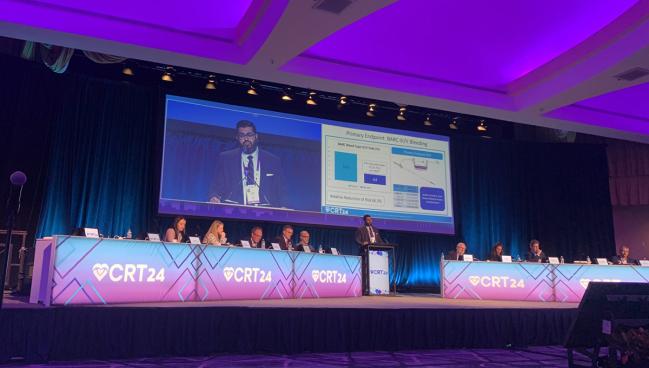SAFE-MCS: Monitoring System Intercepts Bleeding in High-risk PCI
Among those with bleed notifications from the system, manual pressure was the most common intervention required.

WASHINGTON, DC—In patients undergoing high-risk PCI with hemodynamic support, use of a bleeding alert system was associated with less major access-site-related bleeding and allowed for early mitigation measures, according to data from the SAFE-MCS study.
“Bleeding complications have been the Achilles’ heel of hemodynamic support devices,” Babar Basir, DO (Henry Ford Hospital, Detroit, MI), told TCTMD. “This study essentially showed that things are better than they were 10 years ago, and especially now that we have a bleeding detection system, we can be proactive rather than reactive when it comes to bleeding.”
In his presentation here at CRT 2024, Basir said that most patients had circulatory support provided by the Impella CP (Abiomed) left ventricular assist device (LVAD), and that the most frequent intervention that occurred as a result of a notification from the Early Bird Bleed Monitoring System (Saranas) was manual pressure to the access site.
“[We] included an extremely high-risk cohort of patients, 50% who were surgical turndown, 40% who were undergoing atherectomy, 20% who were on a vasopressor and an inotrope,” he noted. “The bleeding device detected bleeding in about 30% of patients. Half of those patients were treated with early medical intervention, which included simple steps such as extra manual pressure to avoid bleeding complications.”
Following the presentation, panelist Hector Garcia-Garcia, MD, PhD (MedStar Washington Hospital Center, Washington, DC), questioned the best way to objectively evaluate the association between the monitoring system and enhanced care.
He added that it would be important to know the hemoglobin curves before and after the procedure as well as rates of blood transfusion, which represent “unbiased” measures that are not dependent on documentation of the event or the dedication of a given care team, which, he noted, could be highly variable.
Basir said the transfusion rate was about 4% and noted that the researchers have hemoglobin curve data that will be available at a later date, as will information on late bleeding.
BARC Type 3 Bleeds Only
SAFE-MCS included 190 patients (mean age 73.5; 27% women; 11% Black) from 11 sites who were undergoing planned complex high-risk PCI using mechanical circulatory support with Impella with femoral access. Nearly 50% of patients had diabetes and more than 25% had renal insufficiency.
The Early Bird monitoring system consists of a standard 30-cm transfemoral sheath, available in 6- or 8-Fr sizes, with two attached electrodes that monitor bioimpedance. An activation device provides notifications about bleeding through visual and audible signals. A level 1 notification is triggered from a change in the signal slope, while level 2 and 3 notifications are triggered by percent change from the baseline impedance.
According to Basir, the mean number of stents per patient was three, with imaging used in 91% of procedures. One-third of procedures involved unprotected left main disease, and 21% involved a chronic total occlusion (CTO).
For the primary endpoint of BARC type 3 to 5 bleeding, the rate was 4.2%, which is a 66% reduction compared with the rate of 12.5% seen in the PROTECT II trial of high-risk PCI with hemodynamic support (P = 0.0003).
The majority of patients (72%) had no alerts from the monitoring system, 21% had level 1 notifications, 5% had level 2 alerts, and 2% had level 3 alerts. All bleeding events in SAFE-MCS were BARC type 3, with half being type 3A and half type 3B. Overall, there was a 96.8% rate of freedom from device-related access-site complications.
To TCTMD, Basir said the lack of any BARC type 4 or 5 bleeding in the cohort was reassuring.
“I think that shows the growth and experience of the last 10 to 15 years,” he said. “Overall, bleeding rates are relatively low, and the bleeding detection system was safe and easy to use. Importantly, the intervention that it leads to is a simple, cost-effective treatment strategy because it's only holding additional pressure.”
L.A. McKeown is a Senior Medical Journalist for TCTMD, the Section Editor of CV Team Forum, and Senior Medical…
Read Full BioSources
Basir B. The safe surveillance of percutaneous coronary intervention under mechanical circulatory support with the Saranas early bird bleeding monitoring system (SAFE-MCS) study. Presented at: CRT 2024. March 10, 2024. Washington, DC.
Disclosures
- SAFE-MCS was funded by Saranas.
- Basir reports consulting for Abiomed, Boston Scientific, Chiesi, Saranas, and Zoll.





Comments